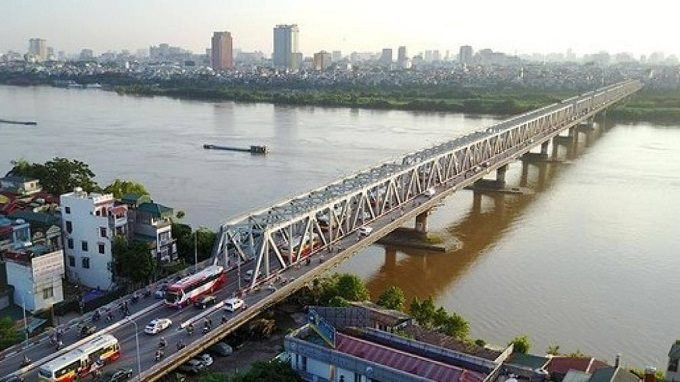The bridges of Hà Nội are more than just structures that connect different parts of the city; they are historical witnesses to the capital’s transformation from a colonial city to a bustling modern metropolis.

Long Biên Bridge: A Hà Nội icon
Constructed by the French from 1898 to 1902, Long Biên Bridge is not only a symbol of Hà Nội but also a lasting testament to Việt Nam’s resilience during years of wars of resistance.
Spanning 2,290m over the Red River, the bridge features 19 steel girders placed on 20 towering piers. The unique design included a single railway track in the centre, flanked by two lanes for vehicles and pedestrians.
Long Biên Bridge, built over 120 years ago, was the first bridge, connecting the two banks of the Red River in Hà Nội, playing a significant role in the city’s history.
The iron bridge welcomed victorious Vietnamese troops returning from resistance bases to take over the capital city from the French occupation forces in the autumn of 1954.
Although it was badly damaged by air bombardments during the US war of destruction of North Việt Nam, the bridge remains a vital link for daily travel today. Additional bridges have been built over the years, transforming Hà Nội into a modern metropolis.

Chương Dương Bridge: A witness to national renewal
Chương Dương Bridge, downstream from Long Biên, was constructed between 1983 and 1985 during a period of post-war reconstruction. At the time, Hà Nội’s need for improved connectivity between urban and suburban areas was growing. Long Biên Bridge was the only means of crossing the Red River, while Thăng Long Bridge was still under construction. The urgency to connect Hà Nội to its surrounding provinces led to the rapid completion of Chương Dương Bridge, entirely designed and built by the Vietnamese. Spanning 1,230m with 21 spans, the bridge was designed to handle 7,000 vehicles per day, but its capacity quickly increased to accommodate three to four times that number, cementing its role in the capital’s expanding transport network.

Đông Trù Bridge: A landmark of architectural innovationCompleted in 2014, Đông Trù Bridge commemorates the 60th anniversary of Hà Nội’s Liberation Day. The bridge was built with advanced technological methods, including the use of concrete-filled steel tube arches with large spans, the first of its kind in Việt Nam. Spanning 1.1 km and connecting Long Biên and Đông Anh districts, Đông Trù Bridge is an integral part of Ring Road 2, improving access to the northern regions of the city and facilitating traffic to Nội Bài International Airport. The bridge’s innovative design and scale are a testament to Việt Nam’s growing expertise in construction.

Nhật Tân Bridge, opened in 2015, is the first cable-stayed bridge in Hà Nội and part of the city's Ring Road 2. Its total length of 8,900m includes a 1,500m central span supported by five diamond-shaped towers symbolising Hà Nội's five city entrances.
The bridge’s design, with its six cable-stayed spans, reflects both engineering prowess and aesthetic elegance. Inaugurated alongside the Nhật Tân-Nội Bài Expressway, the bridge has significantly reduced travel time between Nội Bài International Airport and the city centre.
The project, valued at VNĐ13.6 trillion (US$551 million), is a symbol of the strong diplomatic and economic partnership between Việt Nam and Japan.





























